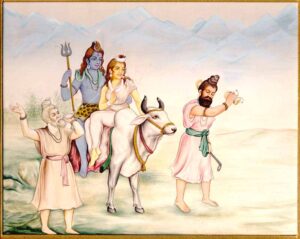YOGA THERAPY OR YOGA CHIKITSA
The Sanskrit term for therapy in its medical literature is Chikitsa, which refers to the application of consciousness (chit) or caring and treatment. Yoga Therapy is called Yoga Chikitsa.
Yet chikitsa as a specific term occurs rarely in any traditional yogic texts or indicates their main concerns. Yoga texts do mention disease as one of the main obstacles in Yoga practice, but do not make countering physical disease as the main purpose of Yoga practice, which aims at the development of higher Consciousness and Self-realization beyond the body and mind.
CHIKITSA RELATIVE TO THE YOGA SUTRAS
The Yoga Sutras is divided into four sections or padas: Samadhi Pada, Sadhana Pada, Vibhuti Pada and Kaivalya Pada.
Samadhi Pada deals with Yoga as Samadhi or unity consciousness and how to realize it, which is the foundation of Yoga. The definition of Yoga (YS.I.2) as chitta-vritti-nirodha or detachment from and mastery over the movements of the mind, is traditionally regarded as a definition of Samadhi. Yoga is Samadhi. That is its first and foremost definition. This nirodha of the mind results in tada drashtuh svarupe avasthanam, or abidance in the Self-nature of the Seer (YS.I.3), referring to the Purusha or Atman, the inner Self. Yoga is transcending body mind for Self-realization or the liberation of Consciousness which occurs through samadhi. This is its primary subject matter.
Sadhana Pada deals with various practices to purify the mind for Samadhi, which is called Sadhana or a way of realization. It begins with the three main practices of Kriya Yoga or the Yoga of Action as tapas, svadhyaya and Ishvara pranidhana. Later it introduces the eight limbs of Yoga or Ashtanga, yamas, niyamas, asana, pranayama, pratyahara, dharana, dhyana and samadhi. These are all aids to purify the mind to lead us to Samadhi as pure consciousness.
Vibhuti Pada deals with the powers and insights that arise from Samadhi in the broader sense of Samyama (combined dharana, dhyana and samadhi), including psychic powers, understanding universal forces, as well as higher wisdom.
Kaivalya Pada relates to Kaivalya, the natural Samadhi state of the Purusha beyond body and mind, Prakriti and the gunas, which is the ultimate goal of Yoga practices. It ends with defining Kaivalya much like the first pada of the text describes the Seer. It says (YS.IV.34), svarupa pratishtha chiti-shakti, when the seeing power (Shakti) of Consciousness rests in its own nature. This is much like the statement of abidance in the Self-nature of the Seer, only the emphasize is on the power of seeing, not simply the Seer.
The second section or Sadhana Pada also introduces the theory of the five Kleshas or factors of suffering for the mind starting with ignorance (avidya) or lack of Self-knolwedge (Atma-vidya), which show how ignorance and egoism give rise to psychological and emotional suffering and forms the basis for Yoga psychology. Here we must remember that Yoga Sutras is more a text on meditation or Raja Yoga than one of physical practices or asana, so this psychological orientation makes sense.
CHIKITSA IN AYURVEDA
The term chikitsa, is very common in Ayurveda and occurs prominently in all Ayurvedic texts, which contain a Chikitsa Sthana or section relating to therapy or treatment. Chikitsa usually goes along with a Nidana section or section relating to diagnosis, which follows from the Ayurvedic healing view of body, mind, doshas, pathology and the disease process. All medical systems require a diagnosis as the basis for therapy and cannot work without them. Ayurvedic chikitsa is broad based and includes diet, herbs, massage, Pancha Karma, surgery, rejuvenation, even Yoga and meditation, extending from lifestyle factors to clinical treatment.
THE RELATIONSHIP OF YOGA AND AYURVEDA IN THERAPY
Traditional Ayurveda includes Yoga as a therapy as part of its Sattavajaya Chikitsa or therapy for increasing sattva guna, which is its main psychological therapy, reducing the psychological doshas of rajas and tamas, where the theories and practices of the Yoga Sutras fit together. It regards Yoga as the means of eliminating spiritual suffering, not just physical or psychological suffering. Ayurveda emphasizes the sattvic living principles of the Yamas and Niyamas of the Yoga Sutras, along with all eight limbs of Yoga, mainly meditation. It is not asana centered, but includes asana.
Chikitsa therefore is a primary term in Ayurveda and a secondary term in Yoga, which is more concerned with sadhana or spiritual practice. Ayurveda mentions Yoga as a therapy mainly in the context of yamas and niyamas as behavioral therapy for the mind. Yet Ayurvedic texts also mention the importance of mantras and honor deities of Ayurveda like Dhanvantari and Shiva, the Lord of Yoga which mainly address psychological or karmic healing.
REINTEGRATION OF YOGA AND AYURVEDA
For any Yoga Chikitsa or Yoga Therapy, the question naturally arises as to what Nidana or diagnosis is the Yoga Therapy based upon? Modern Yoga Therapy is usually an adjunct physical therapy for diseases as diagnosed and treated by modern medicine. There is nothing wrong with that but it can obscure the traditional connection of Yoga Therapy and Vedic Chikitsa with Ayurveda. There is no traditional Yoga Nidana or yogic diagnosis apart from Ayurveda, which employs all methods of observation, touch, pulse and patient examination according to Vedic principles of three doshas, three gunas, five elements, five pranas, agni, chitta and Atman.
For the best results in Yoga therapy we recommend not only a modern medical diagnosis of the conditions it is treating but also an Ayurvedic diagnosis. This connects Yoga Therapy with the broader group of Ayurvedic therapies, from diet and herbs to massage and Ayurvedic clinical methods. It adds considerations of the condition of body and mind according to the three doshas (Vata, Pitta and Kapha) and three gunas (sattva, rajas and tamas) of Vedic thought. It can also bring in Ayurvedic disease theories and stages of disease but also that of the Klesha theory of the Yoga Sutras.
This is what we see in Yoga Therapy that emphasizes treating all five koshas (body, prana, mind, intelligence and bliss), not just a physical or even psychological approach to Yoga and Ayurveda but threefold as body, mind and consciousness. Doshas and gunas are part of this examination. In other words Yoga Therapy or Yoga Chikitsa is an integral part of Ayurveda and should be used along with it. Similarly the Ayurvedic recommendation for meditation and Self-realization occurs under the scope of Yoga and Vedanta.
Such an integration of Yoga and Ayurveda is what we recommend in our books and courses on Yoga and Ayurveda, extending to integrating other Vedic approaches like Vedic counseling, Jyotish and Vastu into both Yoga and Ayurveda.
By Dr. David Frawley (Pandit Vamadeva Shastri)










